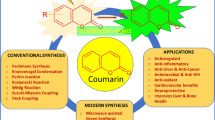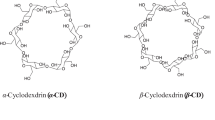Summary
-
1.
Starting from N-arylquinolinium salts, twelve new symmetrical carbocyanines having phenyl and naphthyl radicals on the hetero nitrogen have been prepared.
-
2.
It has been shown that the introduction of phenyl and naphthyl radicals on the hetero nitrogen of quinocarbocyanines causes a bathochromic shift in the absorption maximum, as compared with the N-ethyl compounds, of 10–12 and 14–18 mμ respectively.
-
3.
Introduction of a methyl group in the meso-position of the polymethine chromephore of N-arylcarbocyanines causes an insignificant hypsochromic shift of the absorption maximum, as compared with the unsubstituted compounds.
Similar content being viewed by others
Literature cited
G. T. Pilyugin, Bull. Acad. Sci. USSR. Div. Chem. Sci., No. 2, 353 (1952); G. T. Pilyugin and Z. Ya. Krayner. Proc. Acad. Sci. USSR, 81, 4, 609 (1951).
Konig, Ber. 55, 3292 (1992); F. M. Hainer, J. Chem. Soc. 2796 (1927).
T. Ogata, C. 1932, II, 711; Brit. pat. 34409 (ICI) C. 1931, I, 3297; H. A. Piggot, E. H. Rodd, U.S. Pat. 2071893.
Author information
Authors and Affiliations
Rights and permissions
About this article
Cite this article
Pilyugin, G.T. Cyanine dyes. Russ Chem Bull 1, 491–497 (1952). https://doi.org/10.1007/BF01172003
Received:
Issue Date:
DOI: https://doi.org/10.1007/BF01172003




